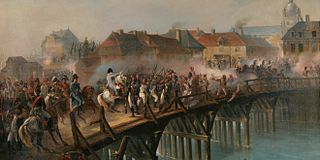 W
WThe Battle of Arcis-sur-Aube saw an Imperial French army under Napoleon face a much larger Allied army led by Karl Philipp, Prince of Schwarzenberg during the War of the Sixth Coalition. On the second day of fighting, Emperor Napoleon suddenly realized he was massively outnumbered, and immediately ordered a masked retreat. By the time the Austrian Field Marshal Schwarzenberg realized Napoleon was retreating, most of the French had already disengaged and the Allied pursuit afterwards failed to prevent the remaining French army from safely withdrawing to the north. This was Napoleon's penultimate battle before his abdication and exile to Elba, the last being the Battle of Saint-Dizier.
 W
WThe Battle of Bazeilles was fought on 1 September 1870 during the Franco-Prussian War as a portion of the larger Battle of Sedan and was one of the first battles to feature modern urban warfare tactics. It took place in Bazeilles, France, a small village in the department of Ardennes near Sedan, and involved a force of Bavarian soldiers battling against French marines and partisans.
 W
WThe Battle of Beaumont on 30 August 1870 was won by Prussia during the Franco-Prussian War.
 W
WThe Battle of Bellevue on 7 October 1870 was fought during the Franco-Prussian War and ended in a Prussian victory.
 W
WThe Battle of Borny–Colombey or the Battle of Colombey-Nouilly took place on 14 August 1870 as part of the Franco–Prussian War. During the battle the escape route of the French army under François Bazaine was blocked when the French encountered the First Army under von Steinmetz. The outcome of the battle itself was indecisive although the French were able to escape to Metz.
 W
WThe Battle of Brienne saw an Imperial French army led by Emperor Napoleon attack Prussian and Russian forces commanded by Prussian Field Marshal Gebhard Leberecht von Blücher. After heavy fighting that went on into the night, the French seized the château, nearly capturing Blücher. However, the French were unable to dislodge the Russians from the town of Brienne-le-Château. Napoleon himself, making his first appearance on a battlefield in 1814, was also nearly captured. Very early the next morning, Blücher's troops quietly abandoned the town and retreated to the south, conceding the field to the French.
 W
WThe Battle of Brumath in 356 AD was part of Roman Emperor Julian's campaigns against the Germanic tribes. Following the Battle of Reims, Julian's forces pursued several Germanic war bands through the Gallic countryside. Outside Brocomagus (Brumath), one war band met Julian in open battle and the Romans were victorious.Hearing therefore that Strasburg, Brumath, Saverne, Seltz, Speyer, Worms, and Mayence were held by the savages, who were living on their lands, he first of all seized Brumath, but while he was still approaching it a band of Germans met him and offered battle. Julian drew up his forces in the form of a crescent, and when the fight began to come to close quarters, the enemy were overwhelmed by a double danger; some were captured, others were slain in the very heat of the battle, and rest got away, saved by recourse to speed.
 W
WThe Battle of the Catalaunian Plains, also called the Battle of the Campus Mauriacus, Battle of Châlons, Battle of Troyes or the Battle of Maurica, took place on June 20, 451 AD, between a coalition led by the Roman general Flavius Aetius and the Visigothic king Theodoric I against the Huns and their vassals commanded by their king Attila. It was one of the last major military operations of the Western Roman Empire, although Germanic foederati composed the majority of the coalition army. Whether the battle was strategically conclusive is disputed: the Romans possibly stopped the Huns' attempt to establish vassals in Roman Gaul. However, the Huns successfully looted and pillaged much of Gaul and crippled the military capacity of the Romans and Visigoths. Attila died only two years later and his Hunnic Empire was dismantled by a coalition of their Germanic vassals after the Battle of Nedao in 454.
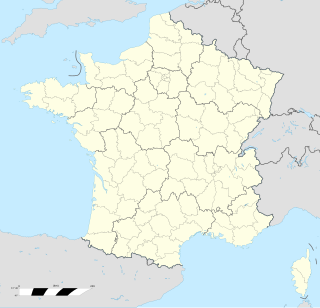 W
WThe Battle of Châlons was fought in 274 between Roman Emperor Aurelian and Emperor Tetricus I of the Gallic Empire. Fought in what is now Châlons-en-Champagne, France, it was the battle that marked the end of the independent Gallic Empire, and its unification back to the Roman Empire, after thirteen years of separation.
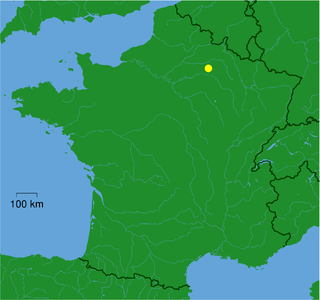 W
WThe Battle of Reims or Battle of Durocortorum was fought in 356 between the Western Roman army led by Western Roman Emperor Julian and the Alemanni. The Alemanni were victorious.And after staying there [ Troyes ] a short time, out of consideration for this tired soldiers, he felt that he ought not to delay, and made for the city of Rheims (Durocortōrum). There he had ordered the whole army to assemble with provisions for a month and to await his coming; the place was commanded by Ursicinus' successor Marcellus, and Ursicinus himself was directed to serve in the same region until the end of the campaign. Accordingly, after the expression of many various opinions, it was agreed to attack the Alamannic horde by way of the Ten Cantons [ Dieuze] with closed ranks; and the soldiers went on in that direction with unusual alacrity. And because the day was misty and overcast, so then even objects close at hand could not be seen, the enemy, aided by their acquaintance with the country, went around by way of a crossroad and made an attack on the two legions bringing up the rear of the Caesar's army. And they would nearly have annihilated them, had not the shouts that they suddenly raised brought up the reinforcements of our allies. Then and thereafter, thinking that he could cross neither roads nor rivers without ambuscades, Julian was wary and hesitant,
 W
WThe Battle of Entzheim, also called Enzheim, or Ensheim, took place on 4 October 1674, during the 1672 to 1678 Franco-Dutch War. It was fought near the town of Entzheim, south of Strasbourg in Alsace, between a French army under Turenne, and an Imperial force commanded by Alexander von Bournonville.
 W
WThe Battle of Fère-Champenoise was fought between two Imperial French corps led by Marshals Auguste de Marmont and Édouard Mortier, duc de Trévise and a larger Coalition force composed of cavalry from the Austrian Empire, Kingdom of Prussia, Kingdom of Württemberg, and Russian Empire. Caught by surprise by Field Marshal Karl Philipp, Prince of Schwarzenberg's main Coalition army, the forces under Marmont and Mortier were steadily driven back and finally completely routed by aggressive Allied horsemen and gunners, suffering heavy casualties and the loss of most of their artillery. Two divisions of French National Guards under Michel-Marie Pacthod escorting a nearby convoy were also attacked and wiped out in the Battle of Bannes. The battleground was near the town Fère-Champenoise located 40 kilometres (25 mi) southwest of Châlons-en-Champagne.
 W
WThe Siege of Fort-Louis saw a force composed of Habsburg Austrians, Hessians and Bavarians led by Franz von Lauer lay siege to Fort-Louis which was held by a Republican French garrison under Michel Durand. The French capitulated after a defense lasting exactly one month. The siege occurred during the War of the First Coalition, part of the French Revolutionary Wars. In 1793 the fortress was sited on an island in the Rhine River, but today Fort-Louis is a village in the Bas-Rhin department in France.
 W
WThe Battle of Gravelotte on 18 August 1870 was the largest battle of the Franco-Prussian War. Named after Gravelotte, a village in Lorraine, it was fought about 6 miles (9.7 km) west of Metz, where on the previous day, having intercepted the French army's retreat to the west at the Battle of Mars-La-Tour, the Prussians were now closing in to complete the destruction of the French forces.
 W
WIn the Siege of Hüningen, the Austrians captured the city from the French. Hüningen is in the present-day Department of Haut-Rhin, France. Its fortress lay approximately 2.5 miles (4.0 km) north of the Swiss city of Basel and .5 miles (0.80 km) north of the spot where the present-day borders of Germany, France and Switzerland meet. During the time of this siege, the village was part of the Canton of Basel City and the fortress lay in area contested between the German states and the First French Republic.
 W
WThe Battle of La Marfée, also known as the Battle of Sedan, took place on 6 July, 1641, during the 1635 to 1659 Franco-Spanish War, a connected conflict of the Thirty Years War.
 W
WThe Battle of La Rothière was fought on the 1st of February 1814 between the French Empire and allied army of Austria, Prussia, Russia, and German States previously allies with France. The French were led by Emperor Napoleon and the coalition army was under the command of Gebhard Leberecht von Blücher. The battle took place in severe weather conditions. The French were defeated but managed to hold until they could retreat under cover of darkness.
 W
WThe Battle of Lingones was fought in 298 between the Western Roman Empire and the Alamanni. The Roman force was led by Constantius Chlorus, and was victorious.
 W
WThe Second Battle of the Marne was the last major German offensive on the Western Front during the First World War. The attack failed when an Allied counterattack, supported by several hundred tanks, overwhelmed the Germans on their right flank, inflicting severe casualties. The German defeat marked the start of the relentless Allied advance which culminated in the Armistice with Germany about 100 days later.
 W
WThe Battle of Mars-La-Tour was fought on 16 August 1870, during the Franco-Prussian War, near the village of Mars-La-Tour in northeast France. One Prussian corps, reinforced by two more later in the day, encountered the entire French Army of the Rhine in a meeting engagement and, surprisingly, forced the Army of the Rhine to retreat toward the fortress of Metz.
 W
WThe Siege of Metz lasting from 19 August – 27 October 1870 was fought during the Franco-Prussian War and ended in a decisive Allied German victory.
 W
WThe Battle of Montmirail was fought between a French force led by Emperor Napoleon and two Allied corps commanded by Fabian Wilhelm von Osten-Sacken and Ludwig Yorck von Wartenburg. In hard fighting that lasted until evening, French troops including the Imperial Guard defeated Sacken's Russian soldiers and compelled them to retreat to the north. Part of Yorck's Prussian I Corps tried to intervene in the struggle but it was also driven off. The battle occurred near Montmirail, France during the Six Days Campaign of the Napoleonic Wars. Montmirail is located 51 kilometres (32 mi) east of Meaux.
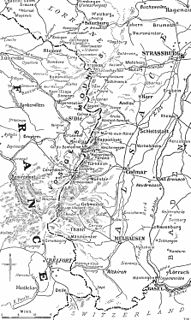 W
WThe Battle of Mulhouse, also called the Battle of Alsace, which began on 7 August 1914, was the opening attack of the First World War by the French Army against Germany. The battle was part of a French attempt to recover the province of Alsace, which France had ceded to the new German Empire following defeat in the Franco-Prussian War of 1870–1871. The French occupied Mulhouse on 8 August and were then forced out by German counter-attacks on 10 August. The French retired to Belfort, where General Louis Bonneau, the VII Corps commander, was sacked along with the commander of the 8th Cavalry Division. Events further north led to the German XIV and XV corps being moved away from Belfort and a second French offensive by the French VII Corps, reinforced and renamed the French Army of Alsace, began on 14 August.
 W
WThe Battle of Noisseville on 31 August 1870 was fought during the Franco-Prussian War and ended in a Prussian victory.
 W
WOperation Nordwind was the last major German offensive of World War II on the Western Front. It began on 31 December 1944 in Rhineland-Palatinate, Alsace and Lorraine in southwestern Germany and northeastern France, and ended on 25 January 1945. The German offensive was an operational failure, with its main objectives not achieved.
 W
WThe Battle of Reims was fought at Reims, France between an Imperial French army commanded by Emperor Napoleon and a combined Russian-Prussian corps led by General Emmanuel de Saint-Priest. On the first day, Saint-Priest's Russians and General Friedrich Wilhelm von Jagow's Prussians easily captured Reims from its French National Guard garrison, capturing or killing more than half of its defenders. On the second day, an overconfident Saint-Priest carelessly deployed his forces west of the city, not grasping that Napoleon was approaching with 20,000 troops. Too late, Saint-Priest realized who he was fighting and tried to organize a retreat. In the battle that followed, the French army struck with crushing force and the Allies were routed with serious losses. During the fighting, Saint-Priest was struck by a howitzer shell and died two weeks later.
 W
WThe Battle of Rocroi, fought on 19 May 1643, was a major engagement of the Thirty Years' War. It was fought between a French army led by the 21-year-old Duke of Enghien and Spanish forces under General Francisco de Melo only five days after the accession of Louis XIV to the throne of France following his father's death. Rocroi is regarded as the graveyard of the myth of invincibility of the Spanish Tercios, the terrifying infantry units that had dominated European battlefields for 120 years up to that point. The battle is therefore often considered to mark the end of Spanish military greatness and the beginning of French hegemony in Europe. After Rocroi, the Spanish abandoned the Tercio system and adopted the Line infantry doctrine like the French.
 W
WThe Battle of Saint-Dizier was a battle during the War of the Sixth Coalition, fought on 26 March 1814, and is notable as Napoleon's last victory before the surrender of Paris and his unconditional abdication.
 W
WThe Battle of Sedan was fought during the Franco-Prussian War from 1 to 2 September 1870. Resulting in the capture of Emperor Napoleon III and large numbers of his troops, it effectively decided the war in favour of Prussia and its allies, though fighting continued under a new French government.
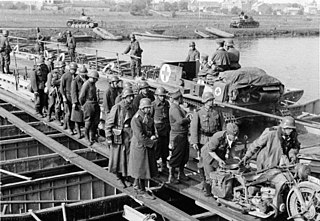 W
WThe Battle of Sedan or Second Battle of Sedan took place in the Second World War during the Battle of France in 1940. It was part of the German Wehrmacht's operational plan codenamed Fall Gelb for an offensive through the hilly and forested Ardennes, to encircle the Allied armies in Belgium and north-eastern France. German Army Group A crossed the Meuse river with the intention of capturing Sedan and pushing northwards towards the Channel coast, to trap the Allied forces that were advancing east into Belgium, as part of the Allied Dyle Plan.
 W
WThe Siege of Strasbourg took place during the Franco-Prussian War, and resulted in the French surrender of the fortress on 28 September 1870.
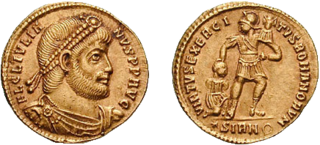 W
WThe Battle of Strasbourg, also known as the Battle of Argentoratum, was fought in 357 between the Western Roman army under the Caesar Julian and the Alamanni tribal confederation led by the joint paramount King Chnodomar. The battle took place near Strasbourg, called Argentoratum in Ammianus Marcellinus' account, Argentorate in the Tabula Peutingeriana.
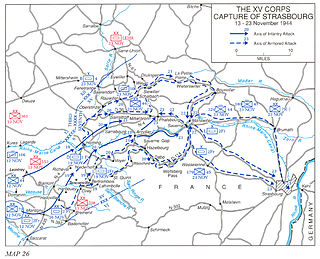 W
WThe liberation of Strasbourg took place on 23 November 1944 during the Alsace campaign in the last months of the Second World War. After the liberation of Mulhouse on 21 November 1944 by the 1st Armored Division, General Philippe Leclerc de Hauteclocque and the 2nd Armored Division entered Strasbourg after having liberated Sarrebourg and La Petite-Pierre, which cleared the way to the city of Strasbourg.
 W
WThe Siege of Thionville was a conflict during the War of the First Coalition. It began at Thionville on 24 August 1792. A coalition force of 20,000 Austrians and 16,000 French Royalist troops under Frederick Louis, Prince of Hohenlohe-Ingelfingen failed to take the town, commanded by Georges Félix de Wimpffen, and raised the siege on 16 October. One of the French royalist troops was François-René de Chateaubriand, who was wounded in the battle. In the aftermath of the siege the National Convention declared that Thionville had "deserved well of the fatherland" - it named Place de Thionville and Rue de Thionville in Paris after the victory.
 W
WThe Siege of Toul was the siege of the fortified French town of Toul from 16 August to 23 September 1870 by Prussian, Bavarian and Württemberg forces during the Franco-Prussian War. Toul controlled a railway line leading to Germany and it was vital for the Germans to secure it to resupply and reinforce their armies in northern France.
 W
WThe Battle of Turckheim was a battle during the Franco-Dutch War that occurred on 5 January 1675 at a site between the towns of Colmar and Turckheim in Alsace. The French army, commanded by the Viscount of Turenne, defeated the armies of Austria and Brandenburg, led by Alexander von Bournonville and Frederick William, Elector of Brandenburg.
 W
WThe Battle of Valmy was the first major victory by the army of France during the Revolutionary Wars that followed the French Revolution. The action took place on 20 September 1792 as Prussian troops commanded by the Duke of Brunswick attempted to march on Paris. Generals François Kellermann and Charles Dumouriez stopped the advance near the northern village of Valmy in Champagne-Ardenne.
 W
WThe first Battle of Verdun was fought on 29 August 1792 between French Revolutionary forces and a Prussian army during the opening months of the War of the First Coalition. The Prussians were victorious, gaining a clear westward path to Paris.
 W
WThe Battle of Verdun, was fought from 21 February to 18 December 1916 on the Western Front in France. The battle was the longest of the First World War and took place on the hills north of Verdun-sur-Meuse. The German 5th Army attacked the defences of the Fortified Region of Verdun and those of the French Second Army on the right (east) bank of the Meuse. Using the experience of the Second Battle of Champagne in 1915, the Germans planned to capture the Meuse Heights, an excellent defensive position with good observation for artillery-fire on Verdun. The Germans hoped that the French would commit their strategic reserve to recapture the position and suffer catastrophic losses at little cost to the Germans.
 W
WThe Battle of Vosges, also referred to as the Battle of Vesontio, was fought in 58 BC between the Germanic tribe of the Suebi, under the leadership of Ariovistus, and six Roman legions under the command of Gaius Julius Caesar. This encounter is the third major battle of the Gallic Wars. Germanic tribes crossed the Rhine, seeking a home in Gaul.
 W
WThe Battle of Wissembourg or Battle of Weissenburg, the first of the Franco-Prussian War, was joined when three German army corps surprised the small French garrison at Wissembourg on 4 August 1870. The defenders, greatly outnumbered, fought stubbornly... especially considering they were surprised and greatly outnumbered, that the French sustained their old renown as fighting men and that the first defeat, although severe, reflected no discredit on the soldiers of the 1st Corps."
 W
WThe Battle of Wörth, also known as the Battle of Reichshoffen or as the Battle of Frœschwiller, refers to the second battle of Wörth, which took place on 6 August 1870 in the opening stages of the Franco-Prussian War. In the second battle, troops from Germany commanded by Crown Prince Frederick and directed by his Chief of Staff, General Leonhard Graf von Blumenthal, defeated the French under Marshal MacMahon near the village of Wœrth in Alsace, on the Sauer River, 10 kilometres (6.2 mi) north of Haguenau.